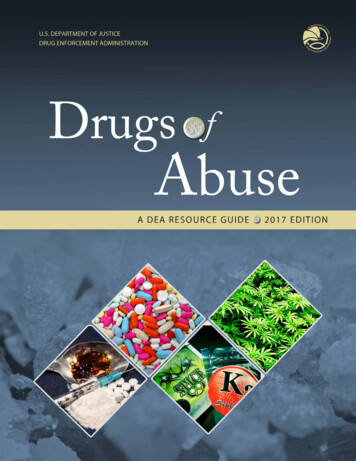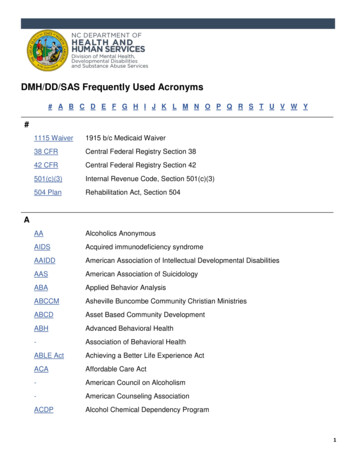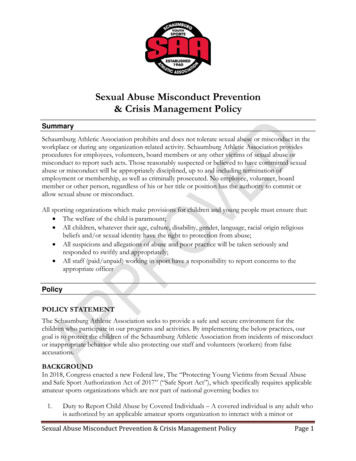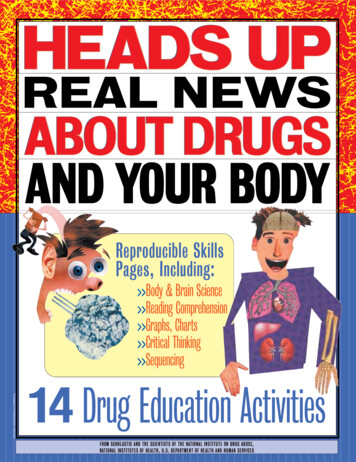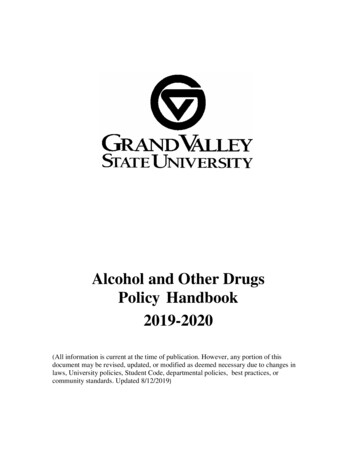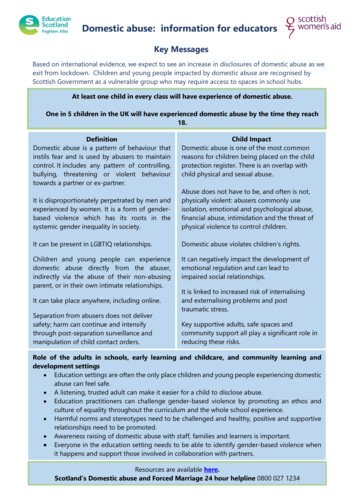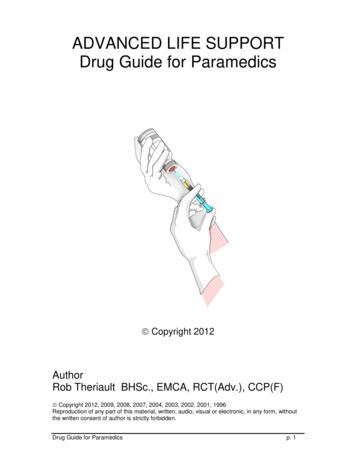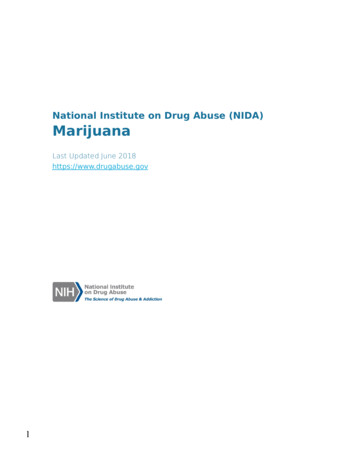
Transcription
National Institute on Drug Abuse (NIDA)MarijuanaLast Updated June 2018https://www.drugabuse.gov1
Table of ContentsMarijuanaLetter From the DirectorWhat is marijuana?What is the scope of marijuana use in the United States?What are marijuana effects?How does marijuana produce its effects?Does marijuana use affect driving?Is marijuana addictive?What are marijuana's long-term effects on the brain?Is marijuana a gateway drug?How does marijuana use affect school, work, and social life?Is there a link between marijuana use and psychiatric disorders?What are marijuana's effects on lung health?What are marijuana’s effects on other aspects of physical health?Is marijuana safe and effective as medicine?What are the effects of secondhand exposure to marijuana smoke?Can marijuana use during and after pregnancy harm the baby?Available Treatments for Marijuana Use DisordersWhere can I get further information about marijuana?References2
Letter From the DirectorPhoto by the NIDAChanges in marijuana policies across states legalizing marijuana formedical and/or recreational use suggest that marijuana is gaininggreater acceptance in our society. Thus, it is particularly important forpeople to understand what is known about both the adverse healtheffects and the potential therapeutic benefits linked to marijuana.Because marijuana impairs short-term memory and judgment anddistorts perception, it can impair performance in school or at work andmake it dangerous to drive. It also affects brain systems that are stillmaturing through young adulthood, so regular use by teens may havenegative and long-lasting effects on their cognitive development,putting them at a competitive disadvantage and possibly interferingwith their well-being in other ways. Also, contrary to popular belief,marijuana can be addictive, and its use during adolescence may makeother forms of problem use or addiction more likely.3
Whether smoking or otherwise consuming marijuana has therapeuticbenefits that outweigh its health risks is still an open question thatscience has not resolved. Although many states now permit dispensingmarijuana for medicinal purposes and there is mounting anecdotalevidence for the efficacy of marijuana-derived compounds, the U.S.Food and Drug Administration has not approved "medical marijuana."However, safe medicines based on cannabinoid chemicals derived fromthe marijuana plant have been available for decades and more arebeing developed.This Research Report is intended as a useful summary of what themost up-to-date science has to say about marijuana and its effects onthose who use it at any age.Nora D. Volkow, M.D.DirectorNational Institute on Drug AbuseSee Also:Message from the NIDA Director - Marijuana’s Lasting Effects onthe Brain, (Archives) (March 2013)4
What is marijuana?Image by iStock.com/nicoolayMarijuana—also called weed, herb, pot, grass, bud, ganja, Mary Jane,and a vast number of other slang terms—is a greenish-gray mixture ofthe dried flowers of Cannabis sativa. Some people smoke marijuana inhand-rolled cigarettes called joints; in pipes, water pipes (sometimescalled bongs), or in blunts (marijuana rolled in cigar wraps).1 Marijuanacan also be used to brew tea and, particularly when it is sold orconsumed for medicinal purposes, is frequently mixed into foods(edibles) such as brownies, cookies, or candies. Vaporizers are alsoincreasingly used to consume marijuana. Stronger forms of marijuanainclude sinsemilla (from specially tended female plants) andconcentrated resins containing high doses of marijuana’s activeingredients, including honeylike hash oil, waxy budder, and hardamberlike shatter. These resins are increasingly popular among thosewho use them both recreationally and medically.5
The main psychoactive (mind-altering) chemical in marijuana,responsible for most of the intoxicating effects that people seek, isdelta-9-tetrahydrocannabinol (THC). The chemical is found in resinproduced by the leaves and buds primarily of the female cannabisplant. The plant also contains more than 500 other chemicals, includingmore than 100 compounds that are chemically related to THC,called cannabinoids.26
What is the scope of marijuanause in the United States?Marijuana is the most commonly used illicit drug (22.2 million peoplehave used it in the past month) according to the 2015 National Surveyon Drug Use and Health.3 Its use is more prevalent among men thanwomen—a gender gap that widened in the years 2007 to 2014.4Marijuana use is widespread among adolescents and young adults.According to the Monitoring the Future survey—an annual survey ofdrug use and attitudes among the Nation’s middle and high schoolstudents—most measures of marijuana use by 8th, 10th, and 12thgraders peaked in the mid-to-late 1990s and then began a period ofgradual decline through the mid-2000s before levelling off. Mostmeasures showed some decline again in the past 5 years. Teens’perceptions of the risks of marijuana use have steadily declined overthe past decade, possibly related to increasing public debate aboutlegalizing or loosening restrictions on marijuana for medicinal andrecreational use. In 2016, 9.4 percent of 8th graders reportedmarijuana use in the past year and 5.4 percent in the past month(current use). Among 10th graders, 23.9 percent had used marijuana inthe past year and 14.0 percent in the past month. Rates of use among12th graders were higher still: 35.6 percent had used marijuana duringthe year prior to the survey and 22.5 percent used in the past month;6.0 percent said they used marijuana daily or near-daily.5Medical emergencies possibly related to marijuana use have alsoincreased. The Drug Abuse Warning Network (DAWN), a system formonitoring the health impact of drugs, estimated that in 2011, therewere nearly 456,000 drug-related emergency department visits in theUnited States in which marijuana use was mentioned in the medicalrecord (a 21 percent increase over 2009). About two-thirds of patientswere male and 13 percent were between the ages of 12 and 17.6 It isunknown whether this increase is due to increased use,increased potency of marijuana (amount of THC it contains), or other7
factors. It should be noted, however, that mentions of marijuana inmedical records do not necessarily indicate that these emergencieswere directly related to marijuana intoxication.8
What are marijuana effects?When marijuana is smoked, THC and other chemicals in the plant passfrom the lungs into the bloodstream, which rapidly carries themthroughout the body to the brain. The person begins to experienceeffects almost immediately (see "How does marijuana produce itseffects?"). Many people experience a pleasant euphoria and sense ofrelaxation. Other common effects, which may vary dramatically amongdifferent people, include heightened sensory perception (e.g., brightercolors), laughter, altered perception of time, and increased appetite.If marijuana is consumed in foods or beverages, these effects aresomewhat delayed—usually appearing after 30 minutes to 1 hour—because the drug must first pass through the digestive system. Eatingor drinking marijuana delivers significantly less THC into thebloodstream than smoking an equivalent amount of the plant. Becauseof the delayed effects, people may inadvertently consume more THCthan they intend to.Pleasant experiences with marijuana are by no means universal.Instead of relaxation and euphoria, some people experience anxiety,fear, distrust, or panic. These effects are more common when a persontakes too much, the marijuana has an unexpectedly high potency, orthe person is inexperienced. People who have taken large doses ofmarijuana may experience an acute psychosis, which includeshallucinations, delusions, and a loss of the sense of personal identity.These unpleasant but temporary reactions are distinct from longerlasting psychotic disorders, such as schizophrenia, that may beassociated with the use of marijuana in vulnerable individuals. (See "Isthere a link between marijuana use and psychiatric disorders?")Although detectable amounts of THC may remain in the body for daysor even weeks after use, the noticeable effects of smoked marijuanagenerally last from 1 to 3 hours, and those of marijuana consumed infood or drink may last for many hours.9
How does marijuana produceits effects?Courtesy of NIDATHC’s chemical structure is similar to the brain chemical anandamide.Similarity in structure allows drugs to be recognized by the body and toalter normal brain communication.THC’s chemical structure is similar to the brain chemical anandamide.Similarity in structure allows the body to recognize THC and to alternormal brain communication.Endogenous cannabinoids such as anandamide (see figure) function asneurotransmitters because they send chemical messages betweennerve cells (neurons) throughout the nervous system. They affect brainareas that influence pleasure, memory, thinking, concentration,movement, coordination, and sensory and time perception. Because ofthis similarity, THC is able to attach to molecules called cannabinoidreceptors on neurons in these brain areas and activate them,disrupting various mental and physical functions and causing theeffects described earlier. The neural communication network that uses10
these cannabinoid neurotransmitters, known as the endocannabinoidsystem, plays a critical role in the nervous system’s normalfunctioning, so interfering with it can have profound effects.For example, THC is able to alter the functioning of the hippocampus(see "Marijuana, Memory, and the Hippocampus") and orbitofrontalcortex, brain areas that enable a person to form new memories andshift his or her attentional focus. As a result, using marijuana causesimpaired thinking and interferes with a person’s ability to learn andperform complicated tasks. THC also disrupts functioning of thecerebellum and basal ganglia, brain areas that regulate balance,posture, coordination, and reaction time. This is the reason people whohave used marijuana may not be able to drive safely (see "Doesmarijuana use affect driving?") and may have problems playing sportsor engaging in other physical activities.People who have taken large doses of the drug may experience anacute psychosis, which includes hallucinations, delusions, and aloss of the sense of personal identity.THC, acting through cannabinoid receptors, also activates the brain’sreward system, which includes regions that govern the response tohealthy pleasurable behaviors such as sex and eating. Like most otherdrugs that people misuse, THC stimulates neurons in the rewardsystem to release the signaling chemical dopamine at levels higherthan typically observed in response to natural stimuli. This flood ofdopamine contributes to the pleasurable "high" that those who userecreational marijuana seek.11
Diagram showing different parts of the brain and describing marijuana'seffects on the brain12
Does marijuana use affectdriving?Photo by iStock.com/MadCirclesMarijuana significantly impairs judgment, motor coordination, andreaction time, and studies have found a direct relationship betweenblood THC concentration and impaired driving ability.7–9Marijuana is the illicit drug most frequently found in the blood ofdrivers who have been involved in vehicle crashes, including fatalones.10 Two large European studies found that drivers with THC in theirblood were roughly twice as likely to be culpable for a fatal crash thandrivers who had not used drugs or alcohol.11,12 However, the roleplayed by marijuana in crashes is often unclear because it can bedetected in body fluids for days or even weeks after intoxication andbecause people frequently combine it with alcohol. Those involved invehicle crashes with THC in their blood, particularly higher levels, arethree to seven times more likely to be responsible for the incident thandrivers who had not used drugs or alcohol. The risk associated with13
marijuana in combination with alcohol appears to be greater than thatfor either drug by itself.8Several meta-analyses of multiple studies found that the risk of beinginvolved in a crash significantly increased after marijuana use13—in afew cases, the risk doubled or more than doubled.14–16 However, alarge case-control study conducted by the National Highway TrafficSafety Administration found no significant increased crash riskattributable to cannabis after controlling for drivers’ age, gender, race,and presence of alcohol.1714
Is marijuana addictive?Marijuana use can lead to the development of problem use, known as amarijuana use disorder, which takes the form of addiction in severecases. Recent data suggest that 30 percent of those who usemarijuana may have some degree of marijuana use disorder.18 Peoplewho begin using marijuana before the age of 18 are four to seventimes more likely to develop a marijuana use disorder than adults.19Marijuana use disorders are often associated with dependence—inwhich a person feels withdrawal symptoms when not taking the drug.People who use marijuana frequently often report irritability, mood andsleep difficulties, decreased appetite, cravings, restlessness, and/orvarious forms of physical discomfort that peak within the first weekafter quitting and last up to 2 weeks.20,21 Marijuana dependence occurswhen the brain adapts to large amounts of the drug by reducingproduction of and sensitivity to its own endocannabinoidneurotransmitters.22,23Marijuana use disorder becomes addiction when the person cannotstop using the drug even though it interferes with many aspects of hisor her life. Estimates of the number of people addicted to marijuanaare controversial, in part because epidemiological studies of substanceuse often use dependence as a proxy for addiction even though it ispossible to be dependent without being addicted. Those studiessuggest that 9 percent of people who use marijuana will becomedependent on it,24,25 rising to about 17 percent in those who startusing in their teens.26,27In 2015, about 4.0 million people in the United States met thediagnostic criteria for a marijuana use disorder;3 138,000 voluntarilysought treatment for their marijuana use.2815
Rising PotencyMarijuana potency, as detected in confiscated samples, hassteadily increased over the past few decades.2 In the early 1990s,the average THC content in confiscated marijuana samples wasroughly 3.8 percent. In 2014, it was 12.2 percent. The averagemarijuana extract contains more than 50 percent THC, with somesamples exceeding 80 percent. These trends raise concerns thatthe consequences of marijuana use could be worse than in thepast, particularly among those who are new to marijuana use or inyoung people, whose brains are still developing (see "What aremarijuana’s long-term effects on the brain?").Researchers do not yet know the full extent of the consequenceswhen the body and brain (especially the developing brain) areexposed to high concentrations of THC or whether the recentincreases in emergency department visits by people testingpositive for marijuana are related to rising potency. The extent towhich people adjust for increased potency by using less or bysmoking it differently is also unknown. Recent studies suggest thatexperienced people may adjust the amount they smoke and howmuch they inhale based on the believed strength of the marijuanathey are using, but they are not able to fully compensate forvariations in potency.30,3116
What are marijuana's long-termeffects on the brain?Substantial evidence from animal research and a growing number ofstudies in humans indicate that marijuana exposure duringdevelopment can cause long-term or possibly permanent adversechanges in the brain. Rats exposed to THC before birth, soon afterbirth, or during adolescence show notable problems with specificlearning and memory tasks later in life.32–34 Cognitive impairments inadult rats exposed to THC during adolescence are associated withstructural and functional changes in the hippocampus.35–37 Studies inrats also show that adolescent exposure to THC is associated with analtered reward system, increasing the likelihood that an animal willself-administer other drugs (e.g., heroin) when given an opportunity(see "Is marijuana a gateway drug?").Imaging studies of marijuana’s impact on brain structure in humanshave shown conflicting results. Some studies suggest regularmarijuana use in adolescence is associated with altered connectivityand reduced volume of specific brain regions involved in a broad rangeof executive functions such as memory, learning, and impulse controlcompared to people who do not use.38,39 Other studies have not foundsignificant structural differences between the brains of people who doand do not use the drug.40Several studies, including two large longitudinal studies, suggest thatmarijuana use can cause functional impairment in cognitive abilitiesbut that the degree and/or duration of the impairment depends on theage when a person began using and how much and how long he or sheused.41Among nearly 4,000 young adults in the Coronary Artery RiskDevelopment in Young Adults study tracked over a 25-year period untilmid-adulthood, cumulative lifetime exposure to marijuana wasassociated with lower scores on a test of verbal memory but did not17
affect other cognitive abilities such as processing speed or executivefunction. The effect was sizeable and significant even after eliminatingthose involved with current use and after adjusting for confoundingfactors such as demographic factors, other drug and alcohol use, andother psychiatric conditions such as depression.42A large longitudinal study in New Zealand found that persistentmarijuana use disorder with frequent use starting in adolescence wasassociated with a loss of an average of 6 or up to 8 IQ points measuredin mid-adulthood.43 Significantly, in that study, those who usedmarijuana heavily as teenagers and quit using as adults did not recoverthe lost IQ points. People who only began using marijuana heavily inadulthood did not lose IQ points. These results suggest that marijuanahas its strongest long-term impact on young people whose brains arestill busy building new connections and maturing in other ways. Theendocannabinoid system is known to play an important role in theproper formation of synapses (the connections between neurons)during early brain development, and a similar role has been proposedfor the refinement of neural connections during adolescence. If thelong-term effects of marijuana use on cognitive functioning or IQ areupheld by future research, this may be one avenue by which marijuanause during adolescence produces its long-term effects.44However, recent results from two prospective longitudinal twin studiesdid not support a causal relationship between marijuana use and IQloss. Those who used marijuana did show a significant decline in verbalability (equivalent to 4 IQ points) and in general knowledge betweenthe preteen years (ages 9 to 12, before use) and late adolescence/earlyadulthood (ages 17 to 20). However, at the start of the study, thosewho would use in the future already had lower scores on thesemeasures than those who would not use in the future, and nopredictable difference was found between twins when one usedmarijuana and one did not. This suggests that observed IQ declines, atleast across adolescence, may be caused by shared familial factors(e.g., genetics, family environment), not by marijuana use itself.45 Itshould be noted, though, that these studies were shorter in durationthan the New Zealand study and did not explore the impact of the dose18
of marijuana (i.e., heavy use) or the development of a cannabis usedisorder; this may have masked a dose- or diagnosis-dependent effect.The ability to draw definitive conclusions about marijuana’s long-termimpact on the human brain from past studies is often limited by thefact that study participants use multiple substances, and there is oftenlimited data about the participants’ health or mental functioning priorto the study. Over the next decade, the National Institutes of Health isfunding the Adolescent Brain Cognitive Development (ABCD) study—amajor longitudinal study that will track a large sample of youngAmericans from late childhood (before first use of drugs) to earlyadulthood. The study will use neuroimaging and other advanced toolsto clarify precisely how and to what extent marijuana and othersubstances, alone and in combination, affect adolescent braindevelopment.Marijuana, Memory, and the HippocampusImage by NIDADistribution of cannabinoid receptors in the rat brain. Brain imagereveals high levels (shown in orange and yellow) of cannabinoidreceptors in many areas, including the cortex, hippocampus,cerebellum, and nucleus accumbens (ventral striatum).19
Memory impairment from marijuana use occurs because THC altershow the hippocampus, a brain area responsible for memory formation,processes information. Most of the evidence supporting this assertioncomes from animal studies. For example, rats exposed to THC in utero,soon after birth, or during adolescence, show notable problems withspecific learning/memory tasks later in life. Moreover, cognitiveimpairment in adult rats is associated with structural and functionalchanges in the hippocampus from THC exposure during adolescence.As people age, they lose neurons in the hippocampus, which decreasestheir ability to learn new information. Chronic THC exposure mayhasten age-related loss of hippocampal neurons. In one study, ratsexposed to THC every day for 8 months (approximately 30 percent oftheir lifespan) showed a level of nerve cell loss at 11 to 12 months ofage that equaled that of unexposed animals twice their age.20
Is marijuana a gateway drug?Some research suggests that marijuana use is likely to precede use ofother licit and illicit substances46 and the development of addiction toother substances. For instance, a study using longitudinal data fromthe National Epidemiological Study of Alcohol Use and RelatedDisorders found that adults who reported marijuana use during the firstwave of the survey were more likely than adults who did not usemarijuana to develop an alcohol use disorder within 3 years; peoplewho used marijuana and already had an alcohol use disorder at theoutset were at greater risk of their alcohol use disorder worsening.47Marijuana use is also linked to other substance use disorders includingnicotine addiction.Early exposure to cannabinoids in adolescent rodents decreases thereactivity of brain dopamine reward centers later in adulthood.48 To theextent that these findings generalize to humans, this could helpexplain the increased vulnerability for addiction to other substances ofmisuse later in life that most epidemiological studies have reported forpeople who begin marijuana use early in life.49 It is also consistent withanimal experiments showing THC’s ability to "prime" the brain forenhanced responses to other drugs.50 For example, rats previouslyadministered THC show heightened behavioral response not only whenfurther exposed to THC but also when exposed to other drugs such asmorphine—a phenomenon called cross-sensitization.51These findings are consistent with the idea of marijuana as a "gatewaydrug." However, the majority of people who use marijuana do not go onto use other, "harder" substances. Also, cross-sensitization is notunique to marijuana. Alcohol and nicotine also prime the brain for aheightened response to other drugs52 and are, like marijuana, alsotypically used before a person progresses to other, more harmfulsubstances.It is important to note that other factors besides biological21
mechanisms, such as a person’s social environment, are also critical ina person’s risk for drug use. An alternative to the gateway-drughypothesis is that people who are more vulnerable to drug-taking aresimply more likely to start with readily available substances such asmarijuana, tobacco, or alcohol, and their subsequent social interactionswith others who use drugs increases their chances of trying otherdrugs. Further research is needed to explore this question.22
How does marijuana use affectschool, work, and social life?Image by iStock.com/AntonioGuillemResearch has shown that marijuana’s negative effects on attention,memory, and learning can last for days or weeks after the acute effectsof the drug wear off, depending on the person’s history with thedrug.53 Consequently, someone who smokes marijuana daily may befunctioning at a reduced intellectual level most or all of the time.Considerable evidence suggests that students who smoke marijuanahave poorer educational outcomes than their nonsmoking peers. Forexample, a review of 48 relevant studies found marijuana use to beassociated with reduced educational attainment (i.e., reduced chancesof graduating).54 A recent analysis using data from three large studiesin Australia and New Zealand found that adolescents who usedmarijuana regularly were significantly less likely than their non-usingpeers to finish high school or obtain a degree. They also had a muchhigher chance of developing dependence, using other drugs, andattempting suicide.55 Several studies have also linked heavy marijuanause to lower income, greater welfare dependence, unemployment,criminal behavior, and lower life satisfaction.56,5723
To what degree marijuana use is directly causal in these associationsremains an open question requiring further research. It is possible thatother factors independently predispose people to both marijuana useand various negative life outcomes such as school dropout.58 That said,people report a perceived influence of their marijuana use on pooroutcomes on a variety of life satisfaction and achievement measures.One study, for example, compared people involved with current andformer long-term, heavy use of marijuana with a control group whoreported smoking marijuana at least once in their lives but not morethan 50 times.59 All participants had similar education and incomebackgrounds, but significant differences were found in theireducational attainment: Fewer of those who engaged in heavycannabis use completed college, and more had yearly householdincomes of less than 30,000. When asked how marijuana affectedtheir cognitive abilities, career achievements, social lives, and physicaland mental health, the majority of those who used heavily reportedthat marijuana had negative effects in all these areas of their lives.Studies have also suggested specific links between marijuana use andadverse consequences in the workplace, such as increased risk forinjury or accidents.60 One study among postal workers found thatemployees who tested positive for marijuana on a pre-employmenturine drug test had 55 percent more industrial accidents, 85 percentmore injuries, and 75 percent greater absenteeism compared withthose who tested negative for marijuana use.6124
Is there a link betweenmarijuana use and psychiatricdisorders?Several studies have linked marijuana use to increased risk forpsychiatric disorders, including psychosis (schizophrenia), depression,anxiety, and substance use disorders, but whether and to what extentit actually causes these conditions is not always easy todetermine.32 The amount of drug used, the age at first use, andgenetic vulnerability have all been shown to influence this relationship.The strongest evidence to date concerns links between marijuana useand substance use disorders and between marijuana use andpsychiatric disorders in those with a preexisting genetic or othervulnerability.62Research using longitudinal data from the National EpidemiologicalSurvey on Alcohol and Related Conditions examined associationsbetween marijuana use, mood and anxiety disorders, and substanceuse disorders. After adjusting for various confounding factors, noassociation between marijuana use and mood and anxiety disorderswas found. The only significant associations were increased risk ofalcohol use disorders, nicotine dependence, marijuana use disorder,and other drug use disorders.63Recent research (see "AKT1 Gene Variations and Psychosis") has foundthat people who use marijuana and carry a specific variant ofthe AKT1 gene, which codes for an enzyme that affects dopaminesignaling in the striatum, are at increased risk of developing psychosis.The striatum is an area of the brain that becomes activated andflooded with dopamine when certain stimuli are present. One studyfound that the risk of psychosis among those with this variant wasseven times higher for those who used marijuana daily compared withthose who used it infrequently or used none at all.6425
Whether adolescent marijuana use can contribute to developing psychosislater in adulthood appears to depend on whether a person already has agenetically based vulnerability to the disorder. The AKT1 gene governs anenzyme that affects brain signaling involving the neurotransmitterdopamine. Altered dopamine signaling is known to be involved inschizophrenia. AKT1 can take one of three forms in a specific region of thegene implicated in susceptibility to schizophrenia: T/T, C/T, and C/C. Thosewho use marijuana daily (green bars) with the C/C variant have a seventimes higher risk of developing psychosis than those who use itinfrequently or use none at all. The risk for psychosis among those withthe T/T variant was unaffected by whether they used marijuana.Source: Di Forti et al. Biol Psychiatry. 2012.Another study found an increased risk of psychosis among adults whohad used marijuana in adolescence and also carried a specific variantof the gene for catechol-O-methyltransferase (COMT), an enzyme thatdegrades neurotransmitters such as dopamine andnorepinephrine65 (see "Genetic Variations in COMT Influences theHarmful Effects of Abused Drugs"). Marijuana use has also been shownto worsen the course of illness in patients who already have
Marijuana is the most commonly used illicit drug (22.2 million people have used it in the past month) according to the 2015 National Survey on Drug Use and Health. Its use is more prevalent among men than women—a gender gap that widened in the years 2007 to 2014. Marijuana



